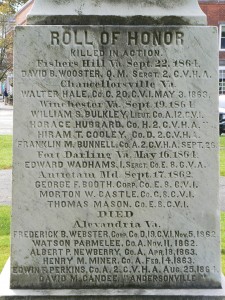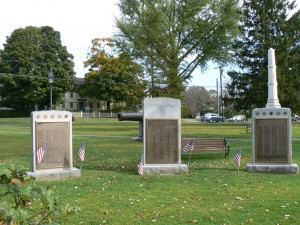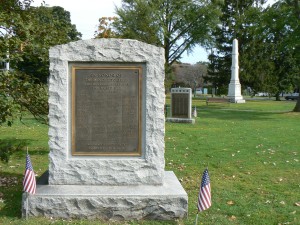 Litchfield honors its Civil War heroes with a marble obelisk on the green.
Litchfield honors its Civil War heroes with a marble obelisk on the green.
A dedication on the front (south) face of the monument, which was dedicated in 1874, reads, “Pro Patria” (“For one’s country in Latin). The dedication is the centerpiece of an artistic bas relief featuring two weeping soldiers, draped flags, crossed rifles and cannonballs.
The south shaft also features an intricate state of Connecticut seal (the ribbon with the state motto extends beyond the shaft’s edges), four flags and a cross that may symbolize the Army of the Potomac’s Sixth Corps (which used a squared-off cross as its emblem). The south shaft also lists the battles of Fisher’s Hill and Fort Darling, both in Virginia.
The east face contains the names, regimental affiliation, and the date and place of death of 20 residents lost in the conflict, and lists the battles of Antietam (Md.) and Fort Harrison (Va.)
 The north face honors 17 residents killed in the war, and lists the battles of Petersburg and North Anna, both in Virginia.
The north face honors 17 residents killed in the war, and lists the battles of Petersburg and North Anna, both in Virginia.
The west face lists 19 residents, as well as the battles of Winchester and Cold Harbor, both in Virginia.
East of the monument, across South Street, is a boulder with a 1908 plaque honoring the former location of a church in which Lyman Beecher, father of Uncle Tom’s Cabin author Harriet Beecher Stowe, preached.
To the southwest is a group of three granite memorials with bronze plaques honoring the veterans of Korea, World War II and Vietnam. The Korea monument has four columns listing residents who served. The World War II monument has plaques on its front and rear, both with four columns, that list a total of 17 residents who were lost in the conflict. The Vietnam memorial has four columns of residents who served, and honors one who was killed.
Near these monuments is the town’s World War monument, which lists four columns of residents who served, and indicates nine were killed.
 A marker south of the Pro Patria monument indicates the site of a recruiting tent for the 19th Connecticut Volunteer Infantry. The unit was formed in Litchfield, and deployed to Washington, D.C., in September of 1862 to serve in the garrison defending the capital. In November of 1863, the regiment shifted from the infantry to the artillery, and became the 2nd Connecticut Heavy Artillery. The unit participated in the 1864 Battle of Cold Harbor and various 1865 engagements around Petersburg, Va. Of the 2,719 men who served in the unit, 409 were killed, injured or died from disease.
A marker south of the Pro Patria monument indicates the site of a recruiting tent for the 19th Connecticut Volunteer Infantry. The unit was formed in Litchfield, and deployed to Washington, D.C., in September of 1862 to serve in the garrison defending the capital. In November of 1863, the regiment shifted from the infantry to the artillery, and became the 2nd Connecticut Heavy Artillery. The unit participated in the 1864 Battle of Cold Harbor and various 1865 engagements around Petersburg, Va. Of the 2,719 men who served in the unit, 409 were killed, injured or died from disease.
The cannon west of the Pro Patria monument was cast in 1845 by the West Point Foundry in Cold Spring, N.Y.
Source: Connecticut Historical Society: Civil War Monuments of Connecticut
Tags: cannon, Litchfield





